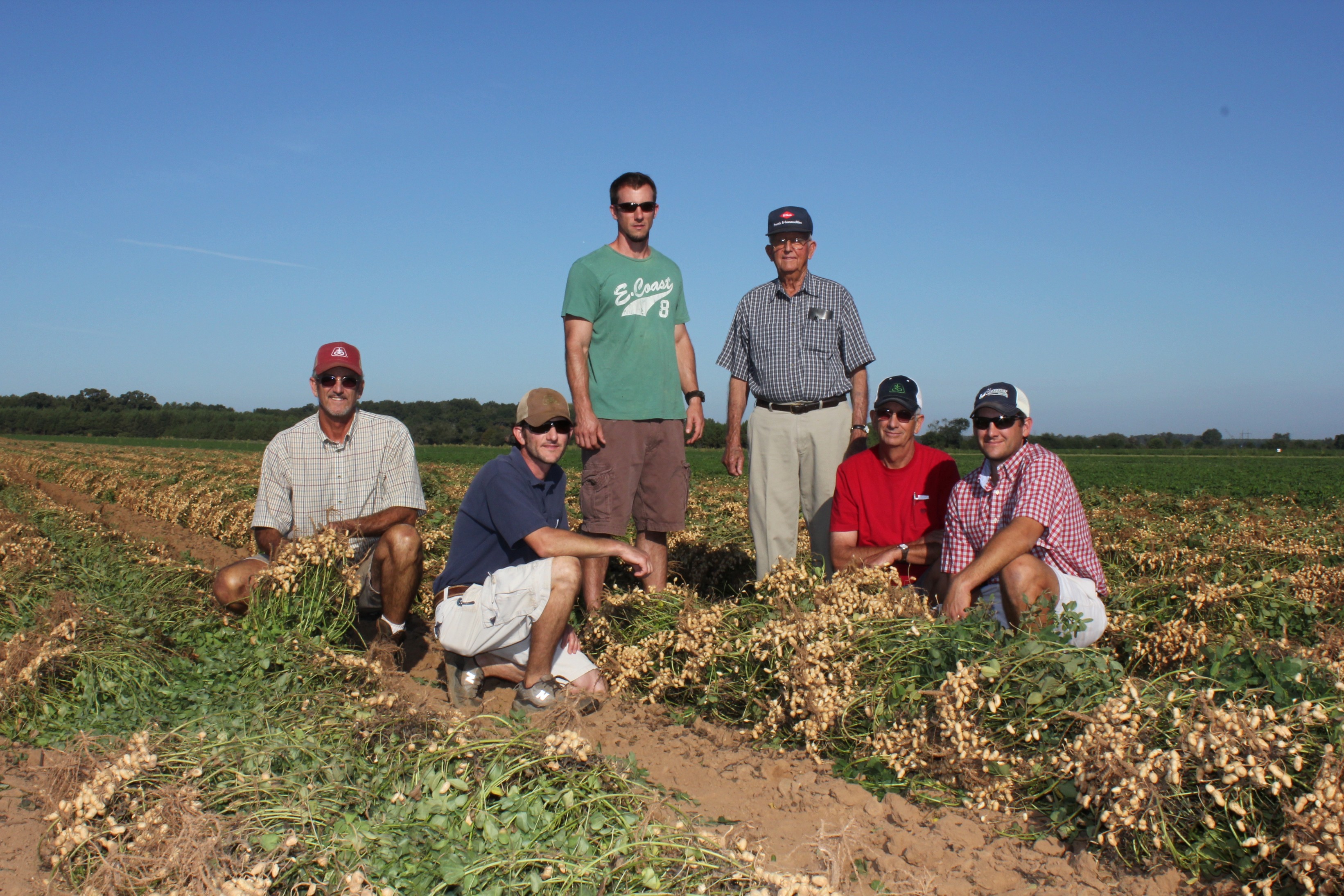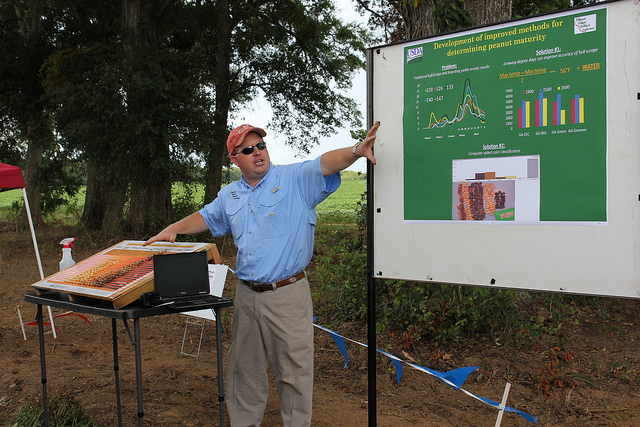A special treat each year on the Georgia Peanut Tour consists of a combination of peanut butter, jelly, bread and butter on a 400 degree griddle. If you want to be even more creative, then ask Tyron Spearman to slice up some apples or bananas to add to your grilled PB&J. The sandwiches are easy to make and a crowd pleaser. Of course, once you sample one, then you will be hooked for life. Thanks to the National Peanut Buying Points Association for grilling those delicious sandwiches every year on the tour. We apologize in advance if this blog post makes you hungry!
“2010 Georgia Peanut Tour”
Foundation Seed Development
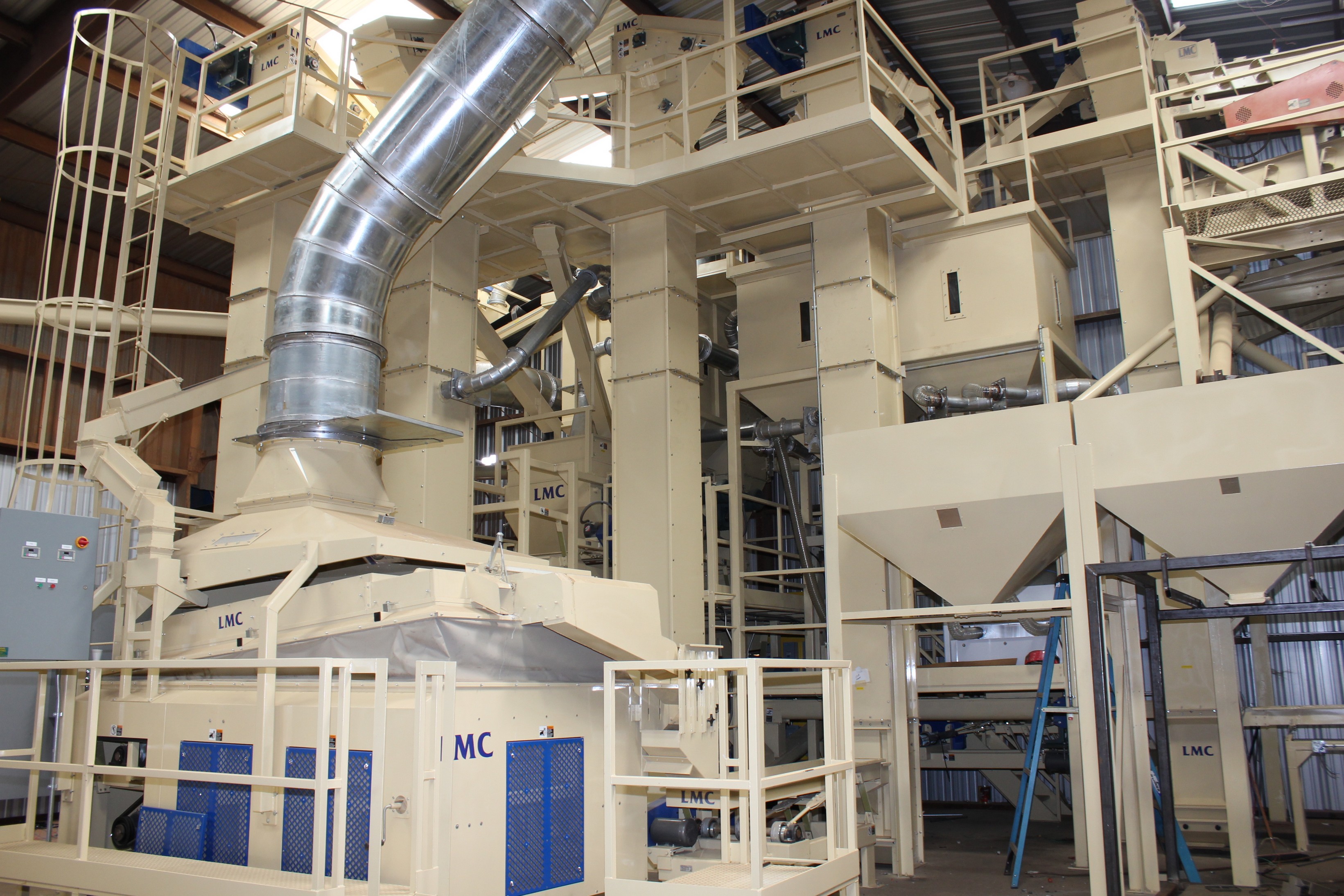
The new peanut sheller at the Georgia Seed Development Commission Foundation Seed Facility in Plains, Ga., has the capacity to shell 6 to 8 tons per hour.
The Georgia Peanut Tour visited the Georgia Seed Development Commission while in Plains, Ga. During the visit, Ralph Johnson, manager of the Foundation Seed Facility in Plains provided an overview of the process for maintaining seed purity at the facility. There are three classes of seed acres in Georgia including certified (89,000 acres), registered (23,000 acres) and foundation (900 acres). The varieties planted this year include GA-06G, GA-07W, Georgia Greener, Tifguard, GA-09B, GA-02C, GA-052529 (experimental line). The commission works to maintain variety purity but the big problem they face is maintaining the anticipated demand for each variety. The equipment in cleaned in between each step from drying to shelling in order to maintain varietal purity. The facility in Plains has recently replaced their 40 year old sheller which had a capacity of shelling 2 to 3 tons per hour. The new sheller has the capacity to shell 6 to 8 tons per hour. Prior to bagging, a seed treatment is applied to protect against seedling disease. The cost of 2.5 to 3 cents per pound is well worth it for the farmer. According to Bob Kemerait, University of Georgia Extension plant pathologist, a farmer receives more value out of that fungicide treatment to protect against diseases which also helps the farmers obtain a good stand after planting. “This is the first and most important investment for the farmer,” Kemerait says. After the seed treatment is applied then the final step of bagging begins and all seed is grouped by lot numbers.
Extreme Heat = White Mold
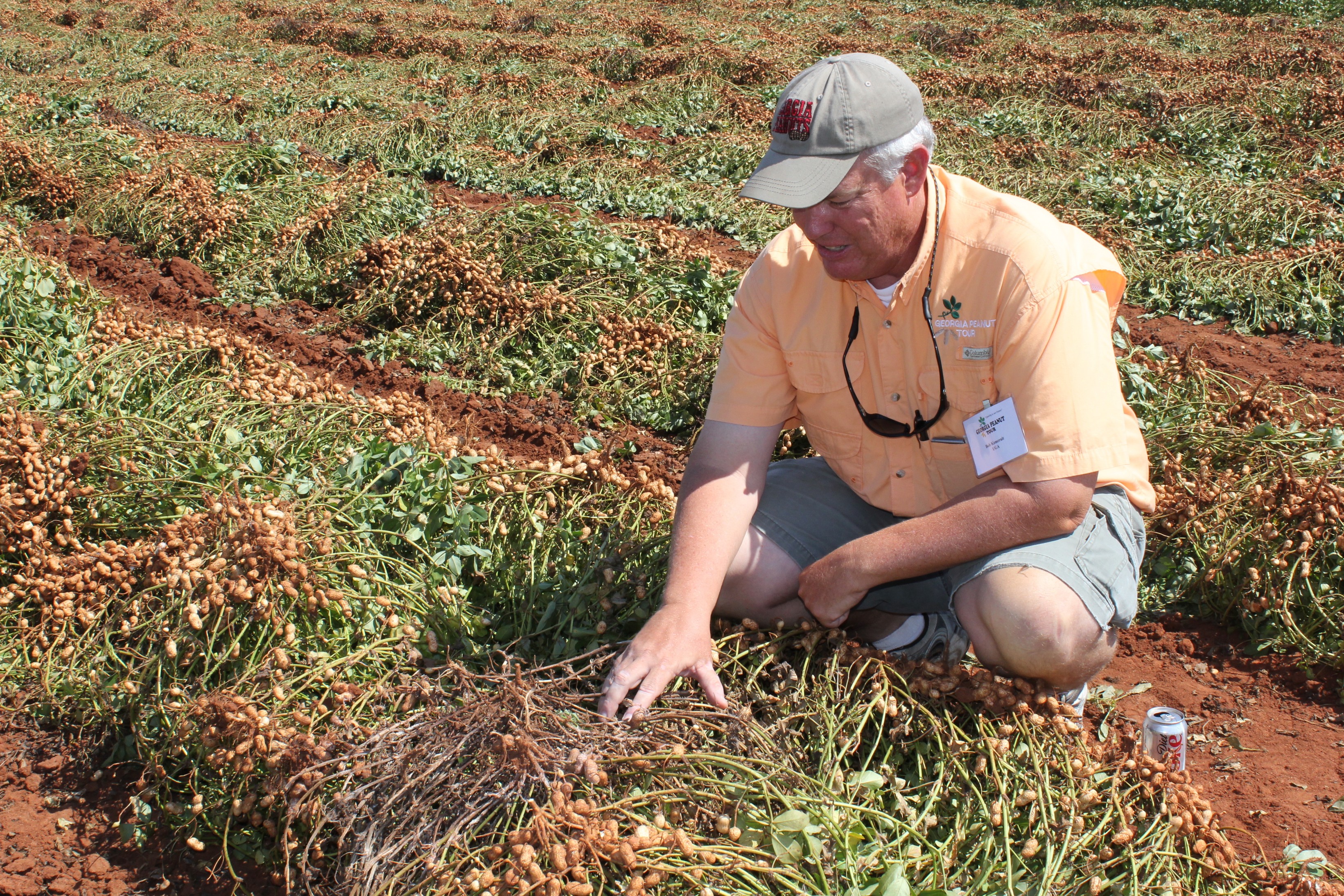
Bob Kemeriat, University of Georgia Extension Plant Pathologist, examines white mold in a peanut field in Marion County, Ga.
Passing green peanut fields along south Georgia’s many country roads at 60 miles per hour make peanut farming look fairly easy. With the exception of pigweeds and Florida beggarweeds that poke above the lush canopy every now and then, the peanut fields can look much like a gently rolling sea of emerald green punctuated here and there by the yellow of small blossoms. The serene image that many visiting our area find so restful, comforting, and even nostalgic belies the true battle between disease and farmer that rages just beneath the upper leaves.
Where did CBR go in 2010?
Tim Brenneman, University of Georgia plant pathologist, discusses peanut disease pressure to attendees during the 2010 Georgia Peanut Tour. “This year has been a very hot year in South Georgia with record high temperatures,” Brenneman says. “Any time you change the environment that much, that also changes the pathogens and the interactions with the plants so we are seeing a different spectrum of disease than we sometimes deal with.” One of the diseases is CBR – Cylindrocladium black rot. CBR is a root infecting pathogen that stays in the soil and it infects the roots under cool, wet conditions. Brenneman has seen almost no disease development this year for CBR. However, the fungus is still there and it has not gone away, he says. He credits later planting by farmers and the overall high temperatures for the absence of CBR in 2010. Learn more by watching the video below.
Breeding New Peanut Varieties
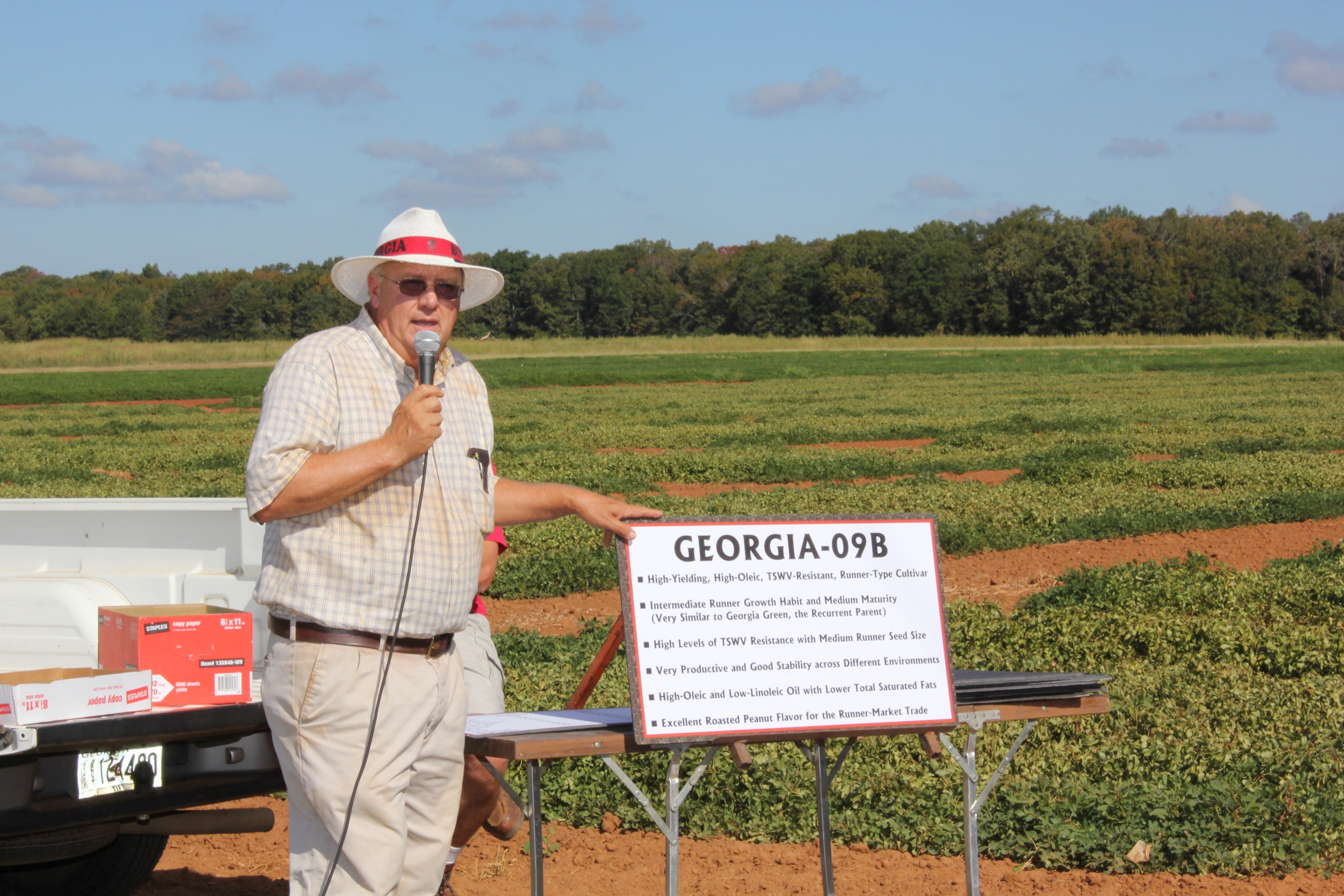
Bill Branch, University of Georgia peanut breeder, discusses information on new peanut varieties available for growers.
Bill Branch, University of Georgia peanut breeder, updated attendees on the Georgia Peanut Tour about peanut breeding and research on peanut varieties. The Georgia Peanut Breeding Program is actively involved in the development of improved varieties with desirable traits for increasing dollar value, yield, grade, disease resistance, insect resistance, virus resistance, nematode resistance, aflatoxin resistance, drought tolerance, better shelling characteristics, longer shelf-life, and enhanced flavor and nutritional qualities. Branch discussed how it can take scientists up to 10 years to fully develop a new variety. In the last several years the Georgia Peanut Breeding Program has released runner-type varieties such as Georgia-06G, Georgia Greener, Georgia-07W, and the most recent Georgia-09B. Georgia-09B is a high-yielding, high-oleic, tomato spotted wilt virus (TSWV)-resistant, medium-seeded, runner-type peanut variety that was released in 2009. Georgia-09B originated from the first backcross made with Georgia Green. Georgia-09B combines the excellent roasted flavor of Georgia Green with the high-oleic trait for longer shelf-life and improved oil quality of peanut and peanut products. This variety and all others mentioned were developed at the University of Georgia, Coastal Plain Experiment Station in Tifton, Ga.
Southwest Georgia Research and Education Center
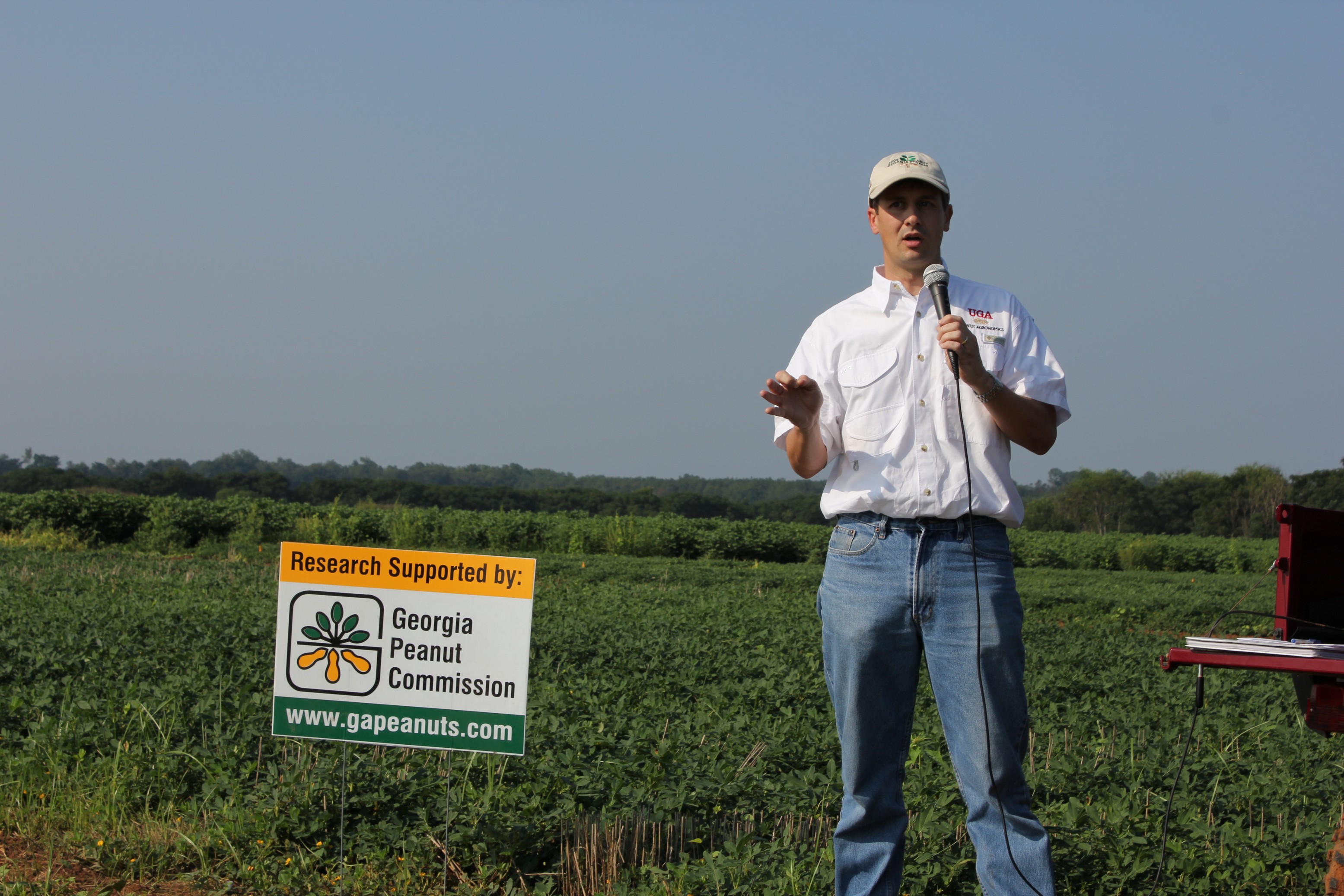
Scott Tubbs, cropping systems agronomist with UGA, discusses his research on rotation and tillage methods.
The Georgia Peanut Tour visited the University of Georgia’s (UGA) Southwest Georgia Research and Education Center which lies in the upper Coastal Plain near Plains, Georgia – the heart of peanut country. The site was selected because of is heavy, red, clay soil that can be difficult to farm but is very productive when carefully managed. The Southwest Georgia Research and Education Center was established in 1951 with 453 acres and has grown to 512 acres with a foundation seed processing unit and a welcome center to highlight former President Jimmy Carter’s hometown for visitors. Research at the center is based on a 240-day growing season and average annual rainfall of 48 inches. This allows field work to be done 10 out of 12 months of the year. Nine full-time employees maintain research for 31 cooperating University of Georgia and U.S. Department of Agriculture researchers. Current research focuses on every major crop in South Georgia including peanuts, cotton, corn, soybeans, grain sorghum, wheat and canola. During the tour, UGA researchers provided updates on peanut breeding, rotation, disease control, and more.
Hagerson Family Farm
Georgia Peanut Tour attendees toured the Hagerson family farm in Sumter County, Ga. to learn more about seed production. Not all peanuts are grown for human consumption, says John Beasley, University of Georgia peanut agronomist. The Hagerson family grows foundation seed for other producers. All of the peanuts grown on the Hagerson farm in 2010 go towards seed increase for growers for 2011. The Hagerson’s grow about 4,500 acres in row crop production of peanuts, cotton, soybeans and green beans. The family has been growing peanut seed for the Georgia Seed Development Commission for 35 years. One of the main crops on the farm is peanuts which consist of 700 acres. The cultivars planted this year on the Hagerson farm include GA-06G, GA-07W and GA-09B. Even though the Hagerson’s grow peanuts for seed production they still face many of the same issues as other growers. The Hargerson’s have had the misfortune like other growers in the state with pigweed that is resistant to glyphosate and ALS chemistry herbicides, particularly Cadre. According to Neil Hagerson, they have been under a terrible stress this year with heat. “We haven’t had any rain in this area for 4 weeks. If it hadn’t been for irrigation then we wouldn’t have a crop this year,” Hagerson says. The Hagerson’s do receive a premium to grow seed peanuts. However, it is worth it since they have more work to do at harvest time. The Hagerson’s have to clean their combines and remove every peanut out of the combine when they move from one cultivar to another. “It’s the little things like that which cost us time,” Hagerson says.
Determining when to dig peanuts
When is the right time to dig? Wilson Faircloth, agronomist with the National Peanut Research Lab in Dawson, Ga., says when farmers can reach maximum yield. In the last 20 days of the production season peanuts gain in yield and some put on 30 percent of their yield in the last two to three weeks of the growing season. Farmers utilize the hull scrape method and peanut profile board to determine when to dig and the resulting yield and grade means money to farmers. Farmers also have to look at the date the peanuts were planted and count the days to maturity. According to Faircloth, farmers can’t just ride by their fields to know when to dig and they can’t put the peanuts back in the ground after digging. Peanuts are an indeterminate crop and some fields planted on the same date may mature at different times based on cultivar selection, soil type or weather patterns. Faircloth says the profile board has some faults and can be time consuming so he is looking into research at the lab that would be more reliable and quicker. The profile board was created more than 30 years ago and there have been numerous cultivars developed since then. Faircloth is looking at a Growing Degree Day Model similar to what cotton producers’ use. Degree days are a measure of the heat units that a plant receives. Growers in Georgia can use the http://www.georgiaweather.net/ to determine temperature for their area and the growing degree days. Faircloth is also looking into using a digital camera, scanner and computer to evaluate the peanuts when determining the digging date. So, there may be new avenues for farmers to consider within the next few years in determining the right time to dig in order to achieve optimum yield and grade.
Chase Family Farms
The Georgia Peanut Tour visited Chase Family Farms in Macon County, Ga. Donald Chase, owner, also serves as a board member of the Georgia Peanut Commission. The farm consists of 1,600 acres and 500 acres in peanuts. Donald credits a lot of the advances he has made on the farm to the researchers and the extension service. Donald planted the GA-O6G peanut cultivar this year on May 6. He utilizes a four-spray fungicide program and sprays at night to control white mold and other diseases. View the video below to learn more about Chase Farms and see peanut digging.
Andersonville National Historic Site
The Georgia Peanut Tour visited the Andersonville National Historic Site in Andersonville, Ga. Andersonville, also known as Camp Sumter, was a Confederate prison camp during the Civil War where over 45,000 Union soldiers were held over the course of 14 months. The prison, which was intended for only 10,000 prisoners, was built in 1864 and was commanded by Captain Henry A. Wirz. The Confederate government could not provide ample food, shelter, medical care, or water to the prisoners. The camp was closed down in the summer of 1865, but by then 13,000 Union soldiers died from overcrowding, malnutrition, disease, poor sanitation, or exposure. Today, the public can view the actual prison camp in which the stockade walls are still standing, the National Prisoner of War Museum, and the Andersonville National Cemetery where over 18,000 deceased veterans are buried.

